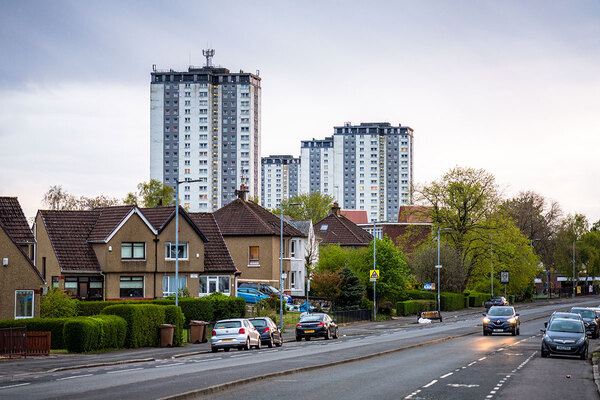Applying the golden thread of building safety to fire doors
What does the ‘golden thread’ mean for fire doors in buildings? Hannah Mansell, group technical director at Masonite UK, explains

Where do fire doors fit within the new legislative landscape of building safety?
The Fire Safety Act that was passed on 29 April 2021 aims to clarify ambiguity in the Fire Safety Order around responsibility for features such as fire doors, external cladding and balconies in multi-occupancy domestic buildings.
The act requires owners and managers of multi-occupancy residential buildings to review and update fire risk assessments to include the structure, external walls and entrance doors to individual flats.
The act applies to all multi-occupied domestic buildings, regardless of height – so the majority of social housing properties will fall under this remit.
The Fire Safety Order states that a ‘responsible person’, or dutyholder, has overall responsibility for fire safety for the building. In addition, the act states that the responsible person must take steps to reduce the risk of fire – rather than simply assess and manage the risk of fire.
On 5 July this year, the Building Safety Bill was introduced. It is concerned with higher-risk residential buildings only, which is defined as those more than 18 metres or seven storeys high, with at least two residential units.
A ‘principal accountable person’ will be legally responsible for registering higher-risk buildings and will have ongoing obligations for monitoring building safety and engaging with residents throughout the building’s occupation.
Accountable persons can be a person or entity, and in the case of social housing would typically be the landlord or a management company.
The principal accountable person must appoint a building safety manager, who must have the organisational capability, relevant skills, knowledge and experience for the role.
This includes understanding the role of fire doors and how they should be specified, fitted and maintained, and recognising the importance of communicating with residents about the importance of measures such as keeping fire doors shut.
What should social landlords consider when choosing fire doors?
When choosing fire doors and doorsets, social landlords need to consider accessibility, as well as thermal, acoustic, durability and security performance alongside fire door performance.
It’s also important to understand the difference between a fire door and a fire doorset.
A fire door usually only refers to the fire door leaf, whereas a fire doorset is supplied fully pre-assembled in the frame, manufactured to the required size and includes all of the correct components such as ironmongery and seals.
Fire doorsets should be third-party tested and certificated using an independent UKAS accredited test house and certification body, such as Warringtonfire and BM TRADA.
Installation must be carried out in accordance with certification and the manufacturer’s guidance, and supported by regular maintenance, to ensure that the product will perform in an emergency.
What information do landlords need to have here to include in the ‘golden thread’ of data – the name given for this consistently updated digital record for very tall buildings?
Once a new building has been approved by the regulator, all building data will be handed over to the accountable persons and building safety manager who must keep the information up-to-date, including details of any refurbishment works. For existing buildings already occupied, accountable persons and building safety managers will be responsible for maintaining this information.
As yet, there are no standards that outline exactly how the information should be kept and updated. With regard to fire doors, as a minimum, details of the doorset or door and ironmongery, manufacturer details and third-party certification, installation details, maintenance records and plans should be kept in an easily accessible digital format.
It is also of critical importance that traceability information for the individual doorset should be maintained to link back to the third-party certification and manufacturer.
What should landlords look for in terms of test evidence and how can they be sure it is accurate?
Social landlords can reassure themselves and their tenants of the fire safety and security performance of doorsets by specifying products that have achieved independent, third-party dual certification.
There are many certification schemes available, but independent third-party schemes can provide the level of integrity to demonstrate that products have been verified by expert, independent third parties and that the information is publicly available to stakeholders.
Landlords should look for product manufacturers that provide clear, reliable test evidence, and are transparent about how they have conducted the tests and achieved the performance stated in certification.
Third-party certification documents and data sheets should be publicly available. The level of detail within the publicly available certification documents and datasheet, and the traceability label affixed to the doorset, both form an integral part of the golden thread.
Together, they play a critical role in ensuring a controlled and compliant approach to managing the product throughout its life.
Making this level of detail available makes it easier for stakeholders to check the complex details of the specification throughout the entire period of time that a product is installed in a building, and therefore gives them more confidence about the fire doorset being specified.
The certificate details the doorsets’ components, the primary test evidence and the third-party certification. Each doorset has a unique serial number that aids traceability of the individual product right back to the digital golden thread, which is critical to the safety system.
What is dual-purpose certification, and what are its benefits?
Dual certification means that building owners and residents can be confident that, for a given doorset, both fire and security have been verified by experts with equal weighting – and that the specification of the doorset is identical, and can perform from both a fire safety and security perspective.
Going forward, dual certification will continue to help manufacturers provide confidence to every single stakeholder in the fire door safety chain. And that’s not just assurances about the manufacturing process now – it’s about the assurance of performance and specification for residents, building owners and responsible people.
Sign up for our fire safety newsletter
Already have an account? Click here to manage your newsletters













